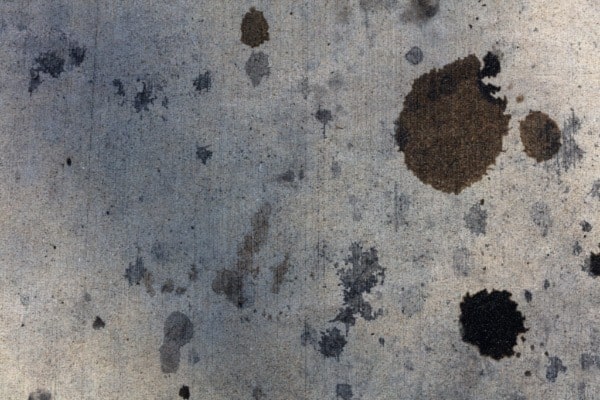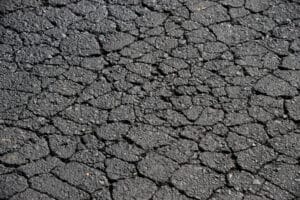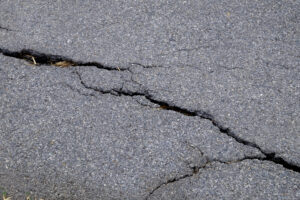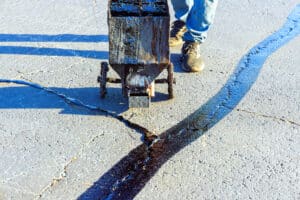Do you own a driveway or parking lot or maintain a freeway? Then you know oil spills are common and challenging to clean up. Not only is the stain unsightly, but it can also cause damage to the asphalt surface if it’s not treated correctly.
Below are some tips on how to remove oil stains from asphalt. We’ll give you a step-by-step guide on what to use and how to get the job done quickly and effectively. So read on and learn how to rid those pesky oil stains from your pavement!
Removing Oil Stains from Asphalt
Asphalt is versatile and durable, but it’s not immune to wear and tear, especially an oil stain. Whether it’s an oil spill from a leaking car, beverages or foods, or animal bodily fluids and waste, these can all stain the asphalt’s surface.
Oil stains are damaging because they permanently embed into the asphalt surface if not addressed quickly. At that point, your only option is an asphalt replacement or sealcoating to cover it. It can be costly to do all this, so removing oil stains from asphalt as soon as possible is critical to preventative maintenance.
Luckily, if the stain is fresh, it can still be removed without pavement professionals. The quicker you act to oil spots on pavement, the better.
Below is a breakdown of how to remove oil stains from asphalt.
Soap and Water
Soap and water are a tried-and-true combination for removing fresh oil stains from asphalt. This method is highly effective for new spills, allowing you to maintain the clean appearance of your pavement. However, it is important to note that this technique does not work for old, set-in oil stains, which may require more intensive treatment or professional cleaning services.
To clean a fresh oil spill on your pavement, follow these steps:
- Pour cat litter or sand over the oil stain to absorb the oil.
- Let the cat litter or sand sit for a few minutes to soak up the spill.
- Clean up and properly dispose of the used cat litter or sand.
- Mix dish soap with warm water.
- Apply the soapy mixture to the oil stain and scrub thoroughly with a stiff brush.
- Rinse the area with water.
- Repeat the process if necessary.
For beverage spills like coffee or other staining liquids, you can substitute dish soap with vinegar. Simply mix vinegar with water and follow the same scrubbing and rinsing steps. Soap and water or vinegar should be sufficient for minor, controlled spills, keeping your pavement looking fresh and well-maintained. If you encounter more stubborn stains or larger spills, consider consulting a professional to ensure your asphalt remains in top condition.
Powdered Detergent
Powdered detergent is another effective method for removing oil stains from asphalt. Similar to the soap and water technique, this approach can help you maintain the clean and appealing look of your pavement. It’s particularly useful for fresh oil spills, ensuring that your asphalt surfaces remain free of unsightly stains and potential hazards.
Here’s a step-by-step guide to using powdered detergent for cleaning oil stains:
- Cover the Oil Spots: Generously sprinkle powdered detergent over the oil stain. Make sure the entire affected area is covered to maximize the cleaning effect.
- Add Water: Lightly wet the powdered detergent with water. Be careful not to use too much water, as you want the detergent to create a thick, cleaning paste.
- Scrub with a Stiff Brush: Using a stiff brush, scrub the detergent into the oil stain. Apply firm pressure to work the detergent deep into the asphalt, breaking down the oil.
- Rinse the Area: Thoroughly rinse the area with water to wash away the detergent and loosened oil particles. You may need to repeat this step several times to ensure all residues are removed.
- Repeat as Necessary: If the stain persists, repeat the process until the oil is completely gone. Multiple applications might be needed for more stubborn stains.
While powdered detergent is effective for fresh oil stains, it’s important to note that this method does not work for old, set-in oil stains. These older stains can be much more challenging to remove and may require specialized cleaning solutions or professional intervention.
WD-40
WD-40 is a water displacement formula that breaks down liquid solutions, displaces the water, and acts as a degreaser. Spray the WD-40 onto the stain, scrub with a stiff brush, and repeat as many times as needed. This cleaning method applies to minor oil spills and stains.
Commercial Degreaser
Not all oil stains are equal. Some oil spots have thicker layers or deeper asphalt penetration. For these types of oil spills, use an industrial-strength degreaser. It can remove oil stains from asphalt that are deeper in the pavement.
Here is how to use commercial degreases for oil stain removal:
- Cover the stained area in degreaser
- Allow the degreaser to sit for at least 10 minutes
- Absorb all liquids and oils with cat litter or sand
- Scrub the area with water and a stiff brush
- Rinse with a hose
Using a commercial degreaser will remove some old oil stains, but in general, it depends on what type of oil it was and how long it was there.
Pressure Washing
Another effective cleaning method to remove oil stains from asphalt is pressure washing. You can buy a pressure washer, rent one, or hire someone to do it for you. A thorough pressure washing will likely eliminate oil spills and leave your asphalt pristine.
Remove and Replace
Consider an asphalt overlay when oil stains become permanently embedded into the asphalt. An asphalt overlay applies a new layer of asphalt onto an existing surface. It hides old oil stains with fresh new pavement onto your driveway or parking lot.
However, an overlay may not work with larger oil stains, especially in parking lots where oil drips regularly from vehicles. This is because oil erodes and ravels the asphalt when left alone. For larger oil stains, the best solution may be to cut and remove the damaged section and patch it with new asphalt.

Asphalt Cleaning Tips
Now that you know how to remove oil stains from asphalt, here are a few tips to make pavement maintenance easier.
Asphalt Sealcoating
A major preventative pavement maintenance tip is to invest in routine sealcoating. Asphalt sealcoating adds a protective layer over your pavement and protects it from the environment. You can prevent oil spills from permanently staining your asphalt by regularly applying sealcoating every few years.
Keeping Your Asphalt Clean
For driveways, regularly sweep and clean your asphalt driveway. When it comes to asphalt pavement maintenance for parking lots, conduct regular cleanliness checks to address any trash, litter, or spills as soon as possible. Keeping your parking lot clean discourages littering in general, although it is always possible.
Investing in a Pressure Washer
Whether you’re a homeowner or a business owner, a pressure washer is a wise investment for keeping your pavement pristine. Pressure washing your driveway or parking lot is a powerful tool for eliminating most oil stains, especially if you address them quickly.
Keep Your Asphalt Clean with Superior Asphalt, LC
Oil stains on asphalt can be tedious, but they can be removed with the proper techniques. Are you looking for a reliable asphalt maintenance company to keep your driveway or parking lot looking its best? Superior Asphalt is here to help.
We offer a wide range of asphalt services for homeowners and property management throughout Utah and Wyoming.
Contact us to learn more about our asphalt repair services and how we can help maintain your property’s appearance today!




